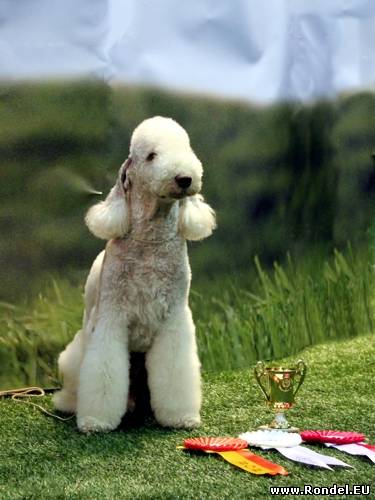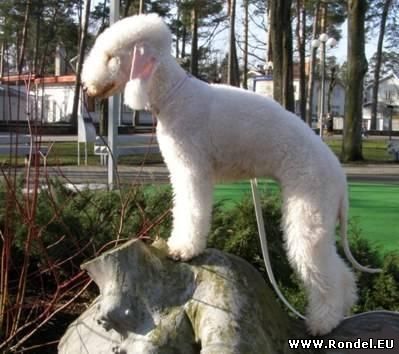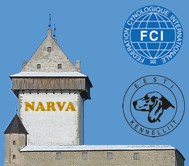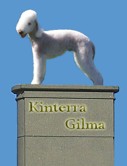Bedlington Terrier History
The best word to describe the Bedlington Terrier is "distinctive." With its soft, wooly coat, tasseled ears, and arched back, the Bedlington resembles no other registered breed. In fact, some Bedlington owners have been asked if the animal on the end of their leash was a sheep! The Bedlington is, however, all dog, and has a long history as a feisty hunter, a tireless worker, and a faithful and funny companion.
 Bedlington Terrier- Kalju |
It may have been in this way that the "gypsy dog" came to the attention of Lord Rothbury of the town of Bedlington in Northumberland County. He became such an enthusiast of the little dog that the breed became known as Rothbury's Terrier (or Rothbury's Lamb). Lord Rothbury's fondness for the breed spread throughout his country. The terrier became a special favorite of the local coal miners, who discovered that its natural instinct to "go to ground" could be put to use ridding the mines of rats. The miners also used the Bedlington for sport, racing them not only against each other but also against the super-fast Whippet-with the Bedlington often coming out the winner.
No one knows for
certain which breeds played a part in the development of the
Bedlington. It shares certain similarities, and therefore possibly
common ancestry, with the Dandie Dinmont, Kerry Blue, and Soft Coated
Wheaten Terriers. Its arched back hints that the Whippet may have also
been used to add speed and litheness to the breed's performance
ability. We do know, however, that the first dog to be called a
"Bedlington Terrier" was whelped in 1825. The dog was Ainsley's Piper,
who started to hunt at 8 months and continued to bring down the most
ferocious of otters and badgers even in his blind and toothless old
age.
A Bedlington loves to play, retrieve, jog, help with chores, or share
your quiet moments. They will curl up in a little ball or become your
inseparable companion as you read, write, sleep, drive, or just sit.
The Bedlington Terrier is graceful, alert, intelligent, and entertaining. They are characteristically inquisitive, perceptive, opinionated and affectionate. Their great love of people and particular joy with children endears them to young and old.
The temperament is two-fold; very quiet, much like a sporting dog, until aroused - then the aggressive terrier spirit dominates.
Bedlingtons are bright, clownish extroverts. They are always anxious to
love please, and be the center of attraction whether in the show ring
or in any room of your house.
Their greatest talent is the running of a household. This includes
being fantastic hosts that leap for joy when company arrives. Astute
judgement of the legitimacy of any visitors has proven them to be
excellent watch dogs.
The breed originated near Bedlington, England. Records can be traced
back to the 18th century. History tells us how the breed was developed
to "go to ground" for game as well as to "run" it down. Their racy form
clearly shows that they are built for speed. Their lean, agile body
makes "going to ground" a snap.

Given the chance, most Bedlingtons today will prove themselves in the
field. They have all the instincts of a good hunting dog: sight, scent,
retrieving, and going to ground. Many are natural pointers. In spite of
these natural attributes, they are rarely put to use as hunting
companions.
Virtually shed-proof, the Bedlington coat is very dark at birth and
becomes much lighter with maturity - and it is "oh, sooo soft!" They do
need to be combed frequently (at least once a week) and trimmed
approximately every two months to keep the coat healthy and beautiful.
A Bedlington breeder should be able to teach you to trim your
Bedlington or advise you on where you can have it done. An excellent
grooming manual is available from the Bedlington Terrier Club of
America.
Living with a Bedlington is a joy. They are easily trained, adaptable,
and versatile companions. Their normal lifespan is about 11 to 16
years. Those who have had the opportunity to live with Bedlingtons of
each gender agree that both males and females are wonderful companions.
If you believe that the Bedlington Terrier is the right dog for you,
contact a good breeder. Good breeders always breed for improvement
using the official standard as their guide.















